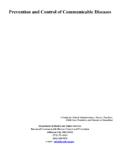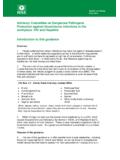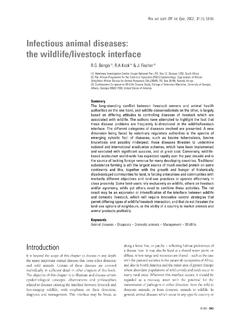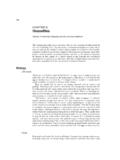Transcription of Global Platform - May 2011 Disaster Risk …
1 Disaster Risk management for health Fact Sheets Key Points Global Platform - May 2011 Disaster Risk management for health COMMUNICABLE DISEASES What are the health risks ? Communicable diseases are a major cause of mortality and morbidity in Disaster situations, particularly, where there is: population displacement collapsing health services lack of disease control programmes poor access to health care in urban and/or ru-ral areas malnutrition interrupted supplies and logistics poor coordination among agencies The risk of communicable diseases is associated pri-marily with the size and characteristics of the affected population7 specifically.
2 Amount and availability of safe water functioning latrines; nutritional status of the displaced population; level of immunity to vaccine-preventable dis-eases such as measles level of access to health care services. Communicable diseases, and the associated risk fac-tors, can be grouped as follows: Water-borne diseases Lack of access to safe water and inadequate sanitation facilities transmission of water-borne and food-borne pathogens. Diarrhoeal diseases such as cholera, ty-phoid fever and shigellosis can cause epidemics with high rates of Hepatitis E has resulted in jaundice and increased mortality in pregnant Leptospirosis is associated with flooding and the in-creased proximity of rats to humans.
3 New pathogens with potential to cause pandemic con-tinue to emerge. Severe Acute Respiratory Syndrome (SARS) caused fewer than 10,000 cases with 774 deaths but had a major impact upon national econo-mies especially upon trade and risks of communicable disease outbreaks arising from natural disasters are fre-quently over- estimated. 1, 2 Outbreak potential is related primarily to population displacement and the conse-quent living conditions. Outbreaks are less frequent in Disaster -affected populations than those affected by Communicable diseases have potential to cause society-wide emergencies such as influenza The main communicable disease causes of morbidity and mortality in disasters are: o diarrhoeal diseases o acute respiratory infections o measles and vector-borne dis-eases High vaccine coverage reduces the inci-dence of vaccine preventable diseases Provision of safe drinking water is the most important preventive measure.
4 Rapid detection of cases of epidemic-prone diseases is essential to ensure rapid control. management of disease vectors in en-demic areas is required to reduce vector Key points PitWhy is this important? The last 2 decades have seen at least 1 billion people affected by natural disasters with millions suffering in-fection with communicable Communicable diseases can cause epidemics and pandemics which have the potential to overwhelm the capacity of communities; hence, they are also consid-ered disasters. During the last century 4 influenza pandemics have occurred resulting in excess of 50 million by the World health Organization, United Kingdom health Protection Agency and partners Further information, contact: WHO - Jonathan Abrahams (e-mail: Developed by the World health Organization, United Kingdom health Protection Agency and partners Vector-borne diseases10 Malaria is endemic in over 80% of areas affected by natural disasters.)
5 Increased risk of death from malaria arises from weak-ened immunity due to: malnutrition co-infection increased exposure to vectors owing to in-adequate shelter collapse of health services Other vector-borne diseases in risk areas include ar-boviruses, such as dengue, yellow fever, Japanese encephalitis and Rift Valley fever, and tick-borne ill-nesses including Crimean Congo haemorrhagic fever and typhus. Diseases associated with overcrowding Measles spreads easily in unvaccinated populations in the crowded conditions and outbreaks are common.
6 Crowding also facilitates the transmission of: meningococcal disease acute respiratory infections tuberculosis infection diarrhoeal diseases. Vaccine-preventable diseases Increased risk of polio, tetanus, pertussis and diphthe-ria is evident when levels of baseline immunization management considerations Governments and communities can manage the risk of communicable diseases in or causing disasters by: Safe water, sanitation, site planning: Provision of safe drinking water is the most important preventive measure.
7 O Planners and engineers are key to ensuring safe water and sanitation infrastructure. o Chlorine is widely available, inexpensive, eas-ily used, and effective against nearly all waterborne pathogens. Primary care: Access to primary care at community level is critical for prevention, early diagnosis, and treatment of a wide range of diseases. Surveillance/early warning system: Rapid detection of cases of epidemic-prone diseases is essential to ensure rapid control. Surveillance and early warning systems should be quickly established to detect outbreaks and monitor priority endemic diseases.
8 International health Regulations IHR11 Imple-mentation of country and sub-national reporting to IHR provides an early warning of new and re-emerging epidemic prone diseases. Immunization: Mass measles immunization and vitamin A supplementation are immediate health priori-ties in areas with inadequate coverage. Prevention of malaria and dengue: Specific preventive interventions for malaria based on an assessment of the local situation could include improving drainage to reduce vector breeding sites. References and further reading 1.
9 1. United Nations Cultural Scientific and Cultural Or-ganization [homepage on the internet]. Paris. About natural disasters. 2. de Ville de Goyet C. Epidemics caused by dead bodies: a Disaster myth that does not want to die. Rev Panam Salud Publica. 2004;15:297 9. 3. Morgan O. Infectious disease risks from dead bod-ies following natural disasters. Rev Panam Salud Publica. 2004;15:307 11. 4. Noji EK. Public health in the aftermath of disasters. BMJ. 2005;330:1379 81. 5. Realities and enigmas of human viral influenza: pathogenesis, epidemiology and control. Vaccine.
10 2002 Aug 19;20(25-26):3068-87. 6. World health Organization. SARS: lessons from a new disease , in The World health Report 2003. 7. Noji E, editor. Public health consequences of disas-ters. New York: Oxford University Press; 1997. 8. Qadri F, Khan Al, Faruque ASG, et al. Enterotoxi-genic Escherichia coli and Vibrio cholera diarrhea, Bangladesh. Emerging Infectious Diseases. 2005;11:1104-7 9. World health Organization. Acute jaundice syn-drome. Weekly Mortality and Morbidity Report. 2006;23:8. 10. Lifson AR. Mosquitoes, models, and dengue. Lan-cet. 1996;347:1201-2 11.
















